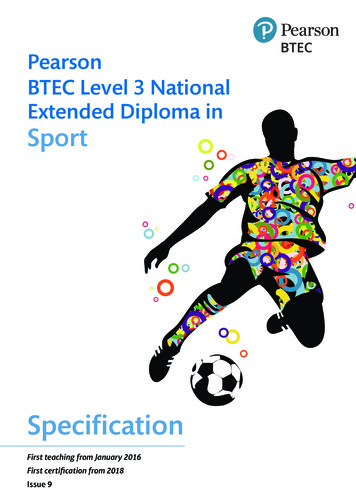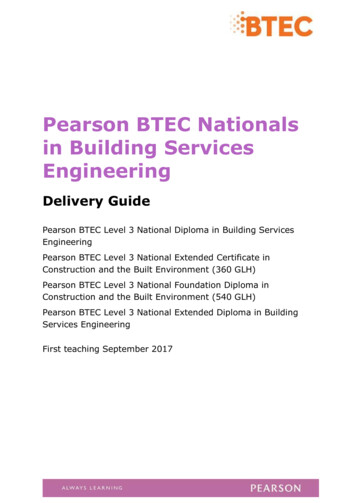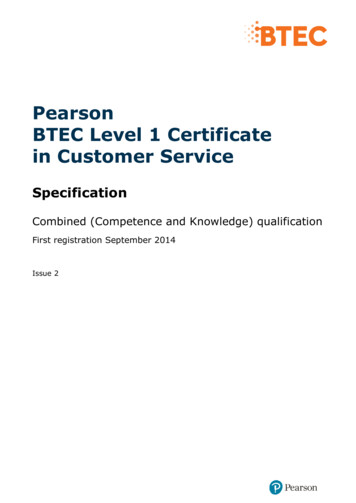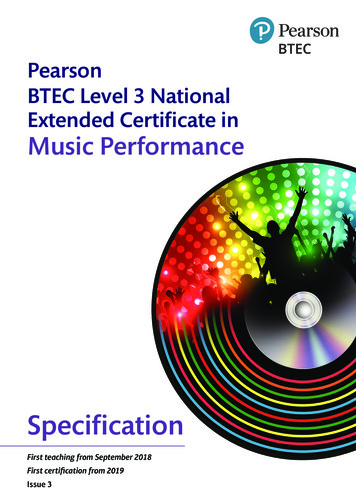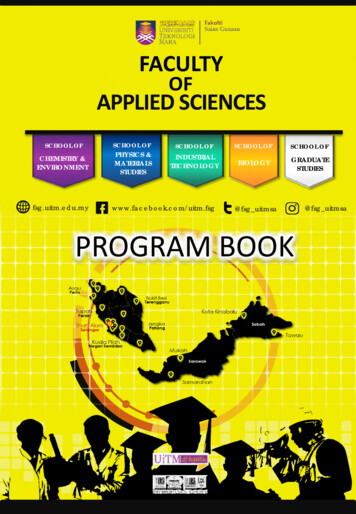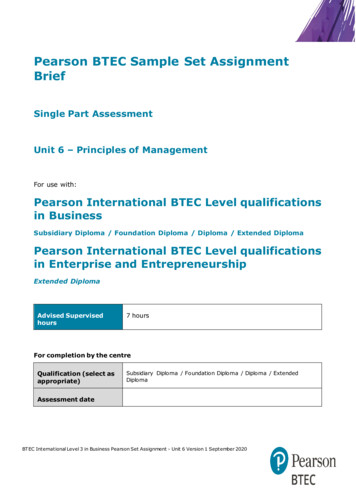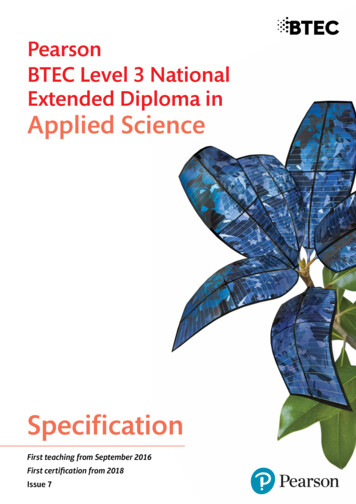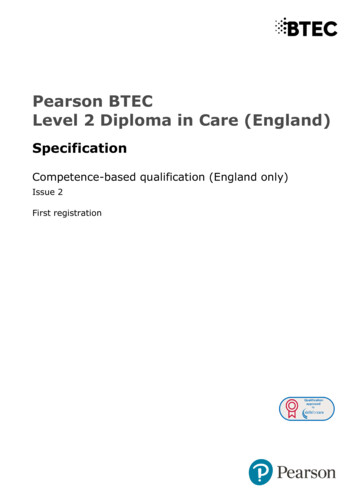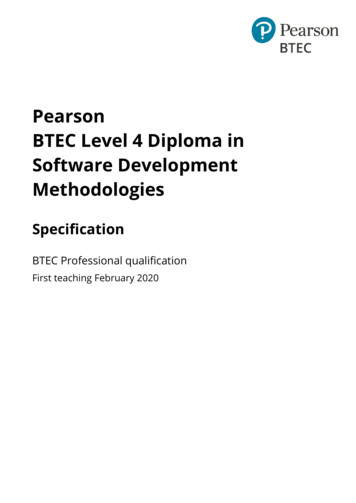
Transcription
PearsonBTEC Level 4 Diploma inSoftware DevelopmentMethodologiesSpecificationBTEC Professional qualificationFirst teaching February 2020
Edexcel, BTEC and LCCI qualificationsEdexcel, BTEC and LCCI qualifications are awarded by Pearson, the UK’s largest awarding bodyoffering academic and vocational qualifications that are globally recognised and benchmarked. Forfurther information, please visit our qualification websites at www.edexcel.com, www.btec.co.uk orwww.lcci.org.uk. Alternatively, you can get in touch with us using the details on our contact us pageat qualifications.pearson.com/contactusAbout PearsonPearson is the world's leading learning company, with more than 24,000 employees in more than70 countries working to help people of all ages to make measurable progress in their lives throughlearning. We put the learner at the centre of everything we do, because wherever learning flourishes,so do people. Find out more about how we can help you and your learners atqualifications.pearson.comReferences to third party material made in this specification are made in good faith. Pearson does notendorse, approve or accept responsibility for the content of materials, which may be subject to change, orany opinions expressed therein. (Material may include textbooks, journals, magazines and otherpublications and websites.)All information in this specification is correct at time of publication.ISBN 978 1 446 96090 5All the material in this publication is copyright Pearson Education Limited 2020
Contents1Introducing BTEC Specialist qualifications1What are BTEC Professional qualifications?1Sizes of BTEC Professional qualifications12Qualification summary and key information33Qualification purpose5Qualification objectives5Apprenticeships5Progression opportunities6Industry support and recognition6Qualification structure7Pearson BTEC Level 4 Diploma in Software Development Methodologies75Centre resource requirements86Access and recruitment9Prior knowledge, skills and understanding9Access to qualifications for learners with disabilities or specific needs947Programme delivery118Assessment12Language of assessment12External assessment13Sample assessment materials14Resits14Administrative arrangements for external assessment14Access arrangements requests14Granting reasonable adjustments15Special consideration requests15Conducting external assessments15Dealing with malpractice in assessment16
9Learner malpractice16Teacher/centre malpractice17Sanctions and appeals17Centre recognition and approval18Approvals agreement1810 UnitUnit 1:19Software Development Methodologies2111 Suggested teaching resources3412 Further information and useful publications3513 Professional development and training36
1 Introducing BTEC Specialist qualificationsWhat are BTEC Professional qualifications?BTEC Professional qualifications are work-related qualifications available from Level 4to Level 8 in a range of sectors. They give learners the knowledge, understanding andskills they need to prepare for employment in a specific occupational area.BTEC Professional qualifications put learning into the context of the world of work,giving learners the opportunity to apply their research, skills and knowledge inrelevant and realistic work contexts. This applied, practical approach means learnersdevelop the knowledge, understanding and skills they need for career progression orfurther study. As such, these qualifications are well suited to support the delivery ofthe Apprenticeship Standards.The qualifications may be offered as full-time or part-time courses in colleges, trainingcentres and through employers.Sizes of BTEC Professional qualificationsFor all regulated qualifications, Pearson specifies a total estimated number of hoursthat learners will require to complete and show achievement for the qualification –this is the Total Qualification Time (TQT). The TQT value indicates the size of aqualification.Within the TQT, Pearson identifies the number of Guided Learning Hours (GLH) thatwe estimate a centre delivering the qualification might provide. Guided learningmeans activities, such as lessons, tutorials, online instruction, supervised study andgiving feedback on performance, that directly involve tutors and assessors in teaching,supervising and invigilating learners. Guided learning includes the time required forlearners to complete external assessment under examination or supervisedconditions.In addition to guided learning, other required learning directed by tutors or assessorsincludes private study, preparation for assessment and undertaking assessment whennot under supervision, such as preparatory reading, revision and independentresearch.As well as TQT and GLH, qualifications can also have a credit value – equal toone-tenth of the TQT, rounded to the nearest whole number.TQT and credit values are assigned after consultation with employers and trainingproviders delivering the qualifications.Pearson BTEC Level 4 Diploma in Software Development Methodologies –Specification – Issue 1 – February 2020 Pearson Education Limited 20201
BTEC Specialist qualifications are generally available in the following sizes: Award – a qualification with a TQT value of 120 or less(equivalent to a range of 1–12 credits) Certificate – a qualification with a TQT value in the range of 121–369(equivalent to a range of 13–36 credits) Diploma – a qualification with a TQT value of 370 or more(equivalent to 37 credits and above).2Pearson BTEC Level 4 Diploma in Software Development Methodologies –Specification – Issue 1 – February 2020 Pearson Education Limited 2020
2 Qualification summary and key informationQualification titlePearson BTEC Level 4 Diploma in SoftwareDevelopment MethodologiesQualification Number (QN)603/5453/7Regulation start date28/01/2020Operational start date01/02/2020Approved age ranges16–1819 Please note that sector-specific requirements orregulations may prevent learners of a particular agefrom embarking on this qualification. Please seeSection 6 Access and recruitment.Total Qualification Time(TQT)370 hours.Guided Learning Hours(GLH)90.AssessmentExternal assessment – multiple-choice test.Grading informationThe qualification and unit are at Pass grade.Entry requirementsNo prior knowledge, understanding, skills orqualifications are required before learners registerfor this qualification. However, it is recommendedthat learners have experience of working in thedigital sector or that they have achieved a relevantqualification, such as a Level 3 information andcommunication technologies qualification.Centres must follow the guidance given in ourdocument A guide to recruiting learners onto Pearsonqualifications (see Section 6 Access and recruitment).FundingQualifications eligible and funded forpost-16-year-olds can be found on the funding Hub.The Education and Skills Funding Agency alsopublishes a funding catalogue that lists thequalifications available for 19 funding.The Apprenticeship funding rules can be found atwww.gov.ukPearson BTEC Level 4 Diploma in Software Development Methodologies –Specification – Issue 1 – February 2020 Pearson Education Limited 20203
Centres will need to use the Qualification Number (QN) when they seek public fundingfor their learners. The qualification title, unit titles and QN will appear on eachlearner’s final certificate. Centres should tell learners this when recruiting them andregistering them with Pearson. There is more information about certification in ourUK Information Manual, available on our website, qualifications.pearson.com4Pearson BTEC Level 4 Diploma in Software Development Methodologies –Specification – Issue 1 – February 2020 Pearson Education Limited 2020
3 Qualification purposeQualification objectivesThe Pearson BTEC Level 4 Diploma in Software Development Methodologies developsthe knowledge and understanding that learners need to carry out the job role ofsoftware developer relating to software development methodologies. Thequalification also enables learners to achieve the knowledge modules required tocomplete the on-programme element of the Software Developer Apprenticeship.The qualification gives learners the opportunity to: develop knowledge related to software development develop technical knowledge and understanding of software developmentmethodologies achieve a Level 4 qualification develop personal growth and engagement in learning.ApprenticeshipsThe Pearson BTEC Level 4 Diploma in Software Development Methodologies meetsone of the mandatory gateway requirements in the Software Developer Level 4Apprenticeship Standard.Learners must achieve this qualification, or the equivalent British Computer Society(BCS) Systems Development Essentials vendor qualification, before progressing to theend-point assessment.The knowledge outcomes from the Software Developer Apprenticeship Standardcovered by the BTEC Level 4 Diploma in Software Development Methodologies are: understands and operates at all stages of the software development lifecycle understands the similarities and differences (taking into account positives andnegatives of both approaches) between agile and waterfall software developmentmethodologies understands how teams work effectively to produce software and contributesappropriately.Pearson BTEC Level 4 Diploma in Software Development Methodologies –Specification – Issue 1 – February 2020 Pearson Education Limited 20205
Progression opportunitiesLearners who achieve the qualification and who have met all other specifiedrequirements of the Software Developer Apprenticeship Standard, can progress toachieving the full Apprenticeship certification that confirms competency in thesoftware developer job role.With further training and development, learners can progress to more senior orcomplex job roles such as senior software developer. Learners will also be eligible toapply for registration onto the Register of IT Technicians, confirming Skills Frameworkfor the Information Age (SFIA) Level 3 professional competence, on completing theapprenticeship.Alternatively, learners who have achieved the qualification but not completed the fullapprenticeship requirements, could progress to a job role such as software engineer,UI designer, UX designer, programmer/coder, applications developer, web developer,games developer or to other qualifications such as the BTEC Level 5 Higher NationalDiploma in Computing.Industry support and recognitionThis qualification is based on the requirements set out in the Software DeveloperApprenticeship Standard issued by the Tech Partnership.The employers involved in creating the Standard are:Accenture, British Airways (BA), The British Computer Society (BCS) – The CharteredInstitute for IT, British Telecom (BT), Capgemini, Cisco, Fujitsu, Hewlett Packard (HP),The International Business Machines Corporation (IBM), John Lewis, Lloyds, Microsoft,National Crime Agency (NCA), Telefonica, The Royal Signals, Telefonica, The TestFactory, Virgin Media, Visa.6Pearson BTEC Level 4 Diploma in Software Development Methodologies –Specification – Issue 1 – February 2020 Pearson Education Limited 2020
4 Qualification structurePearson BTEC Level 4 Diploma inSoftware Development MethodologiesThe learner will need to meet the requirements outlined in the table below beforePearson can award the qualification.1Minimum number of units that must be achievedUnitnumberMandatory unitLevelGuidedLearningHours1Software Development Methodologies490Pearson BTEC Level 4 Diploma in Software Development Methodologies –Specification – Issue 1 – February 2020 Pearson Education Limited 20207
5 Centre resource requirementsAs part of the approval process, centres must make sure that the resourcerequirements below are in place before offering the qualification. Centres must have appropriate physical resources (for example IT, learningmaterials, teaching rooms) to support the delivery and assessment ofthe qualification. Staff involved in the assessment process must have relevant expertise andoccupational experience. There must be systems in place that ensure continuing professional development(CPD) for staff delivering the qualification. Centres must have appropriate health and safety policies in place that relate to theuse of equipment by learners. Centres must deliver the qualifications in accordance with current equalitylegislation. For further details on Pearson’s commitment to the Equality Act 2010,please see Section 6 Access and recruitment. For full details of the Equality Act 2010,visit www.legislation.gov.ukFor information on the requirements for implementing assessment processes incentres, please refer to the BTEC UK Quality Assurance Centre Handbook available onour website.8Pearson BTEC Level 4 Diploma in Software Development Methodologies –Specification – Issue 1 – February 2020 Pearson Education Limited 2020
6 Access and recruitmentOur policy on access to our qualifications is that: they should be available to everyone who is capable of reaching therequired standards they should be free from barriers that restrict access and progression there should be equal opportunities for all wishing to access the qualifications.Centres must ensure that their learner recruitment process is conducted withintegrity. This includes ensuring that applicants have appropriate information andadvice about the qualification to ensure that it will meet their needs.Centres should review applicants’ prior qualifications and/or experience, consideringwhether this profile shows that they have the potential to achieve the qualification.We refer centres to our Equality, diversity and inclusion policy, which can be found inthe support section of our website.Prior knowledge, skills and understandingNo prior knowledge, understanding, skills or qualifications are required for learners toregister for this qualification. However, it is recommended that learners have eitherexperience of working in the digital sector or have achieved a relevant qualification(such as a level 3 information and communication technologies qualification).Access to qualifications for learners with disabilities orspecific needsEquality and fairness are central to our work. Our Equality, diversity and inclusion policyrequires all learners to have equal opportunity to access our qualifications andassessments and that our qualifications are awarded in a way that is fair to everylearner.We are committed to making sure that: learners with a protected characteristic (as defined by the Equality Act 2010) arenot, when they are undertaking one of our qualifications, disadvantaged incomparison to learners who do not share that characteristic all learners achieve the recognition they deserve from undertaking a qualificationand that this achievement can be compared fairly to the achievement oftheir peers.Pearson BTEC Level 4 Diploma in Software Development Methodologies –Specification – Issue 1 – February 2020 Pearson Education Limited 20209
For learners with disabilities and specific needs, the assessment of their potential toachieve the qualification must identify, where appropriate, the support that will bemade available to them during delivery and assessment of the qualification.Please see Section 8 Assessment for information on reasonable adjustments andspecial consideration.10Pearson BTEC Level 4 Diploma in Software Development Methodologies –Specification – Issue 1 – February 2020 Pearson Education Limited 2020
7 Programme deliveryCentres are free to offer this qualification using any mode of delivery that meetslearners’ and employers’ needs. It is recommended that centres make use of a widerange of training delivery methods, including direct instruction in classrooms,simulated demonstrations, research or applied projects, e-learning, directedself-study, field visits and role play. Whichever mode of delivery is used, centres mustmake sure that learners have access to the resources identified in the specificationand to the subject specialists delivering the unit.Centres must adhere to the Pearson policies that apply to the different models ofdelivery. Our document, Collaborative and consortium arrangements for the delivery ofvocational qualifications policy, is available on our website.Those planning the programme should aim to enhance the vocational nature of thequalification by: spending time with employers to better understand their organisationalrequirements and the methods of training that are most suitable, taking intoconsideration their available resources and working patterns collaborating with employers to ensure that learners have opportunities in theworkplace to implement the knowledge and skills developed through thetraining programme developing up-to-date and relevant teaching materials that make use of scenariosrelevant to the sector and relevant occupation giving learners the opportunity to apply their learning in realistic practical activities having regular meetings with employers to discuss learner progress, providingfeedback and agreeing how any issues will be resolved developing projects or assessments, with input from employers.Where legislation is taught, centres must ensure that it is current and up to date.Where a unit is externally assessed, it is essential that learners have covered all of theUnit content before they are tested.For further information on the delivery and assessment of the ApprenticeshipsStandards please refer to document, Apprenticeship funding: rules and guidance foremployers at s.Pearson BTEC Level 4 Diploma in Software Development Methodologies –Specification – Issue 1 – February 2020 Pearson Education Limited 202011
8 AssessmentThe table below gives a summary of the assessment methods used inthe qualification.Assessment methodExternal assessment (onscreen test).In administering external assessments, centres need to be aware of the specificprocedures and policies that apply to, for example, registration, entries and results.More information can be found in our UK Information Manual, available on ourwebsite.Language of assessmentExternal assessments for the unit in this qualification will be available in English only.A learner taking the qualification may be assessed in British or Irish Sign Languagewhere it is permitted for the purpose of reasonable adjustment.Further information on the use of language in qualifications is available in ourUse of languages in qualifications policy document, available on our website.For further information on access arrangements, please refer to the Grantingreasonable adjustments paragraph.12Pearson BTEC Level 4 Diploma in Software Development Methodologies –Specification – Issue 1 – February 2020 Pearson Education Limited 2020
External assessmentThe table below gives information about the type and availability of externalassessments that are available for this qualification. Centres should check thisinformation carefully together with the relevant unit specifications and the sampleassessment materials so that they can timetable learning and assessment periodsappropriately.Unit 1: Software Development MethodologiesType of assessmentOnscreen test using multiple-choice items.Length of asThe external assessment will be 1 hour.assessmentNumber of questions30AssessmentavailabilityOn demandFirst assessmentavailabilityJune 2020Pearson sets and marks the external assessments.The external assessment assesses the learning outcomes in the unit to meet thestandard specified by the related assessment criteria. The content in the unit ismandatory for the assessments and will be sampled across different versions of theassessment over time. Therefore, it is essential that learners have full knowledge ofthe unit content before they are entered for the onscreen test.Centres need to make sure that learners are: fully prepared to sit the external assessments entered for the tests at appropriate times, with due regard for resit opportunitiesas necessary.Information about the structure and format of the assessments is available in the unitin Section 10 Unit.Information about registering learners for the test and the systems requirements fordelivering the onscreen tests is available on our website.Pearson BTEC Level 4 Diploma in Software Development Methodologies –Specification – Issue 1 – February 2020 Pearson Education Limited 202013
Sample assessment materialsEach externally-assessed unit has a set of sample assessment materials (SAMs). TheSAMs are there to provide an example of what the external assessment will look likein terms of the feel and level of demand of the assessment.SAMs show the range of possible question types that may appear in the actualassessments and give a good indication of how the assessments will be structured.While SAMs can be used for practice with learners as with any assessment the contentcovered, and specific details of the questions asked, will change in each assessment.A copy of each of these assessments can be downloaded from the qualification pageon our website.ResitsLearners who take the onscreen test and do not perform as expected are allowed theopportunity to resit the assessment. Opportunity for resits is purely at the centre’sdiscretion. Centres will need to ensure that learners are fully prepared against anyidentified areas of weakness before resitting the assessment.Administrative arrangements for external assessmentAccess arrangements requestsAccess arrangements are agreed with Pearson before an assessment. They allowlearners with special educational needs, disabilities or temporary injuries to: access the assessment show what they know and can do without changing the demands ofthe assessment.Access arrangements should always be processed at the time of registration.Learners will then know what type of arrangement is in place for them.14Pearson BTEC Level 4 Diploma in Software Development Methodologies –Specification – Issue 1 – February 2020 Pearson Education Limited 2020
Granting reasonable adjustmentsFor external assessment, a reasonable adjustment is one that Pearson agrees to makefor an individual learner. A reasonable adjustment is defined for the individual learnerand informed by the list of available access arrangements.Whether an adjustment will be considered reasonable will depend on a number offactors, including: the needs of the learner with the disability the effectiveness of the adjustment the cost of the adjustment; and the likely impact of the adjustment on the learner with the disability andother learners.Adjustment may be judged unreasonable and not approved if it involvesunreasonable costs, timeframes or affects the integrity of the assessment.Special consideration requestsSpecial consideration is an adjustment made to a learner's mark or grade after anexternal assessment to reflect temporary injury, illness or other indisposition at thetime of the assessment.An adjustment is made only if the impact on the learner is such that it is reasonablylikely to have had a material effect on that learner being able to demonstrateattainment in the assessment.Centres are required to notify us promptly of any learners who they believe have beenadversely affected and request that we give special consideration. Further informationcan be found in the special requirements section on our website.Conducting external assessmentsCentres must make arrangement for the secure delivery of external assessments. Allcentres offering external assessments must comply with the Joint Council forQualifications (JCQ) document Instructions for conducting examinations. The currentversion of this document is available on our website.Pearson BTEC Level 4 Diploma in Software Development Methodologies –Specification – Issue 1 – February 2020 Pearson Education Limited 202015
Dealing with malpractice in assessmentMalpractice means acts that undermine the integrity and validity of assessment, thecertification of qualifications and/or may damage the authority of those responsiblefor delivering the assessment and certification.Pearson does not tolerate actual or attempted actions of malpractice by learners,centre staff or centres in connection with Pearson qualifications. Pearson may imposepenalties and/or sanctions on learners, centre staff or centres where malpractice orattempted malpractice has been proven.Malpractice may occur or be suspected in relation to any unit or type of assessmentwithin a qualification. For further details on malpractice and advice on preventingmalpractice by learners, please see Pearson’s Centre Guidance: Dealing withMalpractice, available on our website.Centres are required to take steps to prevent malpractice and to investigate instancesof suspected malpractice. Learners must be given information that explains whatmalpractice is for internal assessment and how suspected incidents will be dealt withby the centre. The Centre Guidance: Dealing with Malpractice document gives fullinformation on the actions we expect you to take.Pearson may conduct investigations if we believe a centre is failing to conduct internalassessment according to our policies. The above document gives further informationand examples and details the penalties and sanctions that may be imposed.In the interests of learners and centre staff, centres need to respond effectively andopenly to all requests relating to an investigation into an incident of suspectedmalpractice.Learner malpracticeThe head of centre is required to report incidents of suspected learner malpracticethat occur during Pearson qualifications. We ask centres to complete JCQ Form M1(www.jcq.org.uk/malpractice) and email it with any accompanying documents(signed statements from the learner, invigilator, copies of evidence, etc) to theInvestigations Processing team at candidatemalpractice@pearson.com. Theresponsibility for determining appropriate sanctions or penalties to be imposed onlearners lies with Pearson.Learners must be informed at the earliest opportunity of the specific allegation andthe centre’s malpractice policy, including the right of appeal. Learners found guilty ofmalpractice may be disqualified from the qualification for which they have beenentered with Pearson.Failure to report malpractice constitutes staff or centre malpractice.16Pearson BTEC Level 4 Diploma in Software Development Methodologies –Specification – Issue 1 – February 2020 Pearson Education Limited 2020
Teacher/centre malpracticeThe head of centre is required to inform Pearson’s Investigations team of any incidentof suspected malpractice (which includes maladministration) by centre staff, beforeany investigation is undertaken. The head of centre is requested to inform theInvestigations team by submitting a JCQ M2 Form (downloadable fromwww.jcq.org.uk/malpractice) with supporting documentation topqsmalpractice@pearson.com. Where Pearson receives allegations of malpracticefrom other sources (for example Pearson staff, anonymous informants), theInvestigations team will conduct the investigation directly or may ask the head ofcentre to assist.Pearson reserves the right in cases of suspected malpractice to withhold the issuing ofresults/certificates while an investigation is in progress. Depending on the outcome ofthe investigation, results and/or certificates may not be released, or they may bewithheld.We reserve the right to withhold certification when undertaking investigations, auditsand quality assurance processes. You will be notified within a reasonable period oftime if this occurs.Sanctions and appealsWhere malpractice is proven, we may impose sanctions or penalties, such as: mark reduction for affected external assessments disqualification from the qualification debarment from registration for Pearson qualifications for a period of time.If we are concerned about your centre’s quality procedures, we may impose sanctionssuch as: working with centres to create an improvement action plan requiring staff members to receive further training placing temporary blocks on the centre’s certificates placing temporary blocks on registration of learners debarring staff members or the centre from delivering Pearson qualifications suspending or withdrawing centre approval status.The centre will be notified if any of these apply.Pearson has established procedures for centres that are considering appeals againstpenalties and sanctions arising from malpractice. Appeals against a decision made byPearson will normally be accepted only from the head of centre (on behalf of learnersand/or members or staff) and from individual members (in respect of a decision takenagainst them personally). Further information on appeals can be found in the JCQAppeals Booklet son BTEC Level 4 Diploma in Software Development Methodologies –Specification – Issue 1 – February 2020 Pearson Education Limited 202017
9 Centre recognition and approvalCentres that have not previously offered BTEC Specialist qualifications need to applyfor, and be granted, centre recognition as part of the process for approval to offerindividual qualifications.Existing centres will be given ‘automatic approval’ for a new qualification if they arealready approved for a qualification that is being replaced by a new qualification andthe conditions for automatic approval are met.Centres offering mandatory qualifications for the Apprenticeship Standards must belisted on the Education and Skills Funding Agency’s Register of Training Organisationsand have a contract to deliver these.Guidance on seeking approval to deliver BTEC qualifications is given on our website.Approvals agreementAll centres are required to enter into an approval agreement with Pearson, in whichthe head of centre or principal agrees to meet all the requirements of the qualificationspecification and to comply with the policies, procedures, codes of pract
covered by the BTEC Level 4 Diploma in Software Development Methodologies are: understands and operates at all stages of the software development lifecycle understands the similarities and differences (taking into account positives and negatives of both approaches) between agile and waterfall software development methodologies
